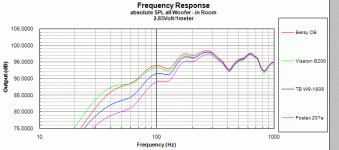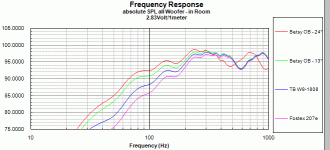Having recently built an OB using the neat little Betsy (Qts .78) driver and having carefully watched others build OBs with 8" drivers my question is...
When adding helper woofers up to approx 200hz do you need to use drivers with high Qts? I see many happy with low .26 Qts Fostex 207e and the latest TB has a Qts of .44... not typical for OB use. Linkwitz uses an 8" Seas with a Qts of .34...
TIA,
Godzilla
When adding helper woofers up to approx 200hz do you need to use drivers with high Qts? I see many happy with low .26 Qts Fostex 207e and the latest TB has a Qts of .44... not typical for OB use. Linkwitz uses an 8" Seas with a Qts of .34...
TIA,
Godzilla
I can't find better answer than - try with MJK's MathCad sheets .
that way you'll skip much of a guessing ......
I simulated even FR drivers , intended for BLH - and they seamlessly blended with Eminence Alpha 15
that way you'll skip much of a guessing ......
I simulated even FR drivers , intended for BLH - and they seamlessly blended with Eminence Alpha 15
The qts and fs, in conjunction with the baffle size determines response (mostly). Narrow baffles need high q bass drivers if you want flat response down to near fs. The best way to determine which drivers will work well is to model them. On the other hand, you can quite easily design an OB without any software at all but it will likely need some (possibly very significant) tweaking after the fact that could be avoided with good modelling in the design process.
Here's how to design OB using no tools except driver specs and your head. Easy as pie, except for the fact that it's not easy to guess where (and how bad) the first big diffraction peak will be without modelling. OB Design (amateur audio)
Nothing beats a good simulation though. In addition to XLBaffle (free) and MJK's software (inexpensive) there's also the new version of Passive Crossover Designer (free - released yesterday) that claims to be more accurate than XLBaffle - and obviously, being a crossover designer, you can model whole speakers, not just the bass driver.
If you have any specific questions and don't feel care to get into modelling, I can model stuff for you.
Here's how to design OB using no tools except driver specs and your head. Easy as pie, except for the fact that it's not easy to guess where (and how bad) the first big diffraction peak will be without modelling. OB Design (amateur audio)
Nothing beats a good simulation though. In addition to XLBaffle (free) and MJK's software (inexpensive) there's also the new version of Passive Crossover Designer (free - released yesterday) that claims to be more accurate than XLBaffle - and obviously, being a crossover designer, you can model whole speakers, not just the bass driver.
If you have any specific questions and don't feel care to get into modelling, I can model stuff for you.
Last edited:
Siegfried Linkwitz uses electronic equalization to compensate for the low-frequency roll-off. There's lots of info on his website: Linkwitz Lab - Loudspeaker Design
In MJK's '3 driver OB' worksheet (where two of the drivers are woofers and one a wide-ranger), the Fostex FE166 and 167 seem to substitute readily for each other despite one having a lower Qt and being intended for BLH rather than BR use. So, I suspect Qt doesn't matter so much if you're rolling off the bass anyway.
Bill
Bill
Thanks for your replies! I downloaded xlBaffle and noticed it does not require the Qts measurement when doing its calculation. I thought that was odd... especially for an OB measuring tool. Am i missing something?
Thanks,
Godzilla
Thanks,
Godzilla
Am i missing something?
Thanks,
Godzilla
Yes. Qts can be derived from qms and qes, so it knows. How are you doing with it? Is it working out for you? As I mentioned you might also want to try Passive Crossover Designer for it's OB design feature if you have excel.
Godzilla,
When you are building a speaker with more of a "play with it till it works" methodology, it can't hurt to have more wiggle room. And, the Betsy's high Qts is going to give you a little more to work with in the midbass than the BetsyK. You could certainly incorporate a lower Qts driver with a helper woofer, but the less energy you have to work with around 150hz, the fewer your options. In an ideal world, you would always have a high pass filter on a fullranger running with a helper woofer. There again, more midbass gives you more options as you might be able to use a steeper and/or higher corner on your filter.
Bill, the Qts difference between the 166 and 167 is not very large, that is probably why you don't see a big difference in the simulations. Either that or you are crossing over high enough that the driver resonance doesn't really matter.
The Betsy's high Qts is necessary so that it will work on an OB all by itself. But, when you add a helper woofer, the BetsyK and it's lower Qts is certainly a viable option too. Neither is necessarily better in that application. The ideal choice will depend on the rest of the design.
Paul
Wild Burro Audio Labs - DIY Full Range Speakers
When you are building a speaker with more of a "play with it till it works" methodology, it can't hurt to have more wiggle room. And, the Betsy's high Qts is going to give you a little more to work with in the midbass than the BetsyK. You could certainly incorporate a lower Qts driver with a helper woofer, but the less energy you have to work with around 150hz, the fewer your options. In an ideal world, you would always have a high pass filter on a fullranger running with a helper woofer. There again, more midbass gives you more options as you might be able to use a steeper and/or higher corner on your filter.
Bill, the Qts difference between the 166 and 167 is not very large, that is probably why you don't see a big difference in the simulations. Either that or you are crossing over high enough that the driver resonance doesn't really matter.
The Betsy's high Qts is necessary so that it will work on an OB all by itself. But, when you add a helper woofer, the BetsyK and it's lower Qts is certainly a viable option too. Neither is necessarily better in that application. The ideal choice will depend on the rest of the design.
Paul
Wild Burro Audio Labs - DIY Full Range Speakers
I think i understand your q now.
the answer is yes, unless you want to get into eq or a zillion "helpers".
the answer is yes, unless you want to get into eq or a zillion "helpers".
Thanks for the replies! I downloaded xlBaffle and simmed some of the drivers i was interested in. The results were not surprising actually. The drivers are all on a 20 x 48 inch baffle, at the same location on the baffle, the same distance away from the back and side walls. Different positioning and baffle sizes result in better or worse responses but i kept them all the same for this comparison.
Betsy -4db @ 100hz (Qts .78)
Visaton B200 -5db @ 100hz (Qts .75)
TB W8-1808 -6db @ 100hz (Qts .44)
Fostex 207e -8db @ 100hz (Qts .27)
They all can be crossed to a woofer at around 150hz but the Betsy and Visaton can be crossed anywhere from 100hz - 150hz so the higher Qts drivers allow more wiggle room than the low. I still want to play with a few more drivers but have a feeling the findings will be similar.
Thanks so much!
Godzilla
Betsy -4db @ 100hz (Qts .78)
Visaton B200 -5db @ 100hz (Qts .75)
TB W8-1808 -6db @ 100hz (Qts .44)
Fostex 207e -8db @ 100hz (Qts .27)
They all can be crossed to a woofer at around 150hz but the Betsy and Visaton can be crossed anywhere from 100hz - 150hz so the higher Qts drivers allow more wiggle room than the low. I still want to play with a few more drivers but have a feeling the findings will be similar.
Thanks so much!
Godzilla
Attachments
just out of curiosity I have tried 207s in 13''x36'' baffle with single subwoofer actively crossed at about 250hz not perfect but, impressive sound . if memory serves me right MJK mentioned somewhere that any FR drivers can be used on OB with woofer help.
Vadim
Vadim
Good work, Zilla.
When I use XLBaffle I get rid of the all boundaries (except floor) by placing the walls as far away as possible.
When I use XLBaffle I get rid of the all boundaries (except floor) by placing the walls as far away as possible.
Interesting about the 207s on the 13 inch baffle.
Would the high qts of the betsy allow you to use it one a very narrow baffle, on top of an h-frame helper woofer?
For instance if your baffle was 10 to 11 inches wide, would the Betsy still be able to reach the x-over point around 200hz?
Would the high qts of the betsy allow you to use it one a very narrow baffle, on top of an h-frame helper woofer?
For instance if your baffle was 10 to 11 inches wide, would the Betsy still be able to reach the x-over point around 200hz?
Last edited:
I think so many speakers + H-frames will work great! If i get a moment at work tomorrow i will model the Betsy on a 13" wide baffle and see what happens.
Godzilla
Godzilla
Is there an available software allowing to model an h-frame with a full- range driver
Is there an available software allowing to model an h-frame with a full- range driver in OB ?
In MJK's mathcad, it's currently not possible (maybe in the future ?).
Having a lowther driver (currently in a horn) I d like to check what could be done with two alpha 15 in H-Frame per side and the lowther on the top (bi-amplified system).
Is there an available software allowing to model an h-frame with a full- range driver in OB ?
In MJK's mathcad, it's currently not possible (maybe in the future ?).
Having a lowther driver (currently in a horn) I d like to check what could be done with two alpha 15 in H-Frame per side and the lowther on the top (bi-amplified system).
I think the "Q" should be relied on the whole system, not only the driver itself. So why not try increasing (adjusting) the output impedance of the amp to have a proper system Q? So you'll have much more options in choosing drivers.
http://www.diyaudio.com/forums/multi-way/155022-low-q-woofer-ob-high-zo-amp.html
http://www.diyaudio.com/forums/multi-way/155022-low-q-woofer-ob-high-zo-amp.html
Is that bump at 600hz for all of the drivers on the 13 inch baffle, the first dipole peak?
Whizzer-less Betsy + ribbon might be fun😀
Whizzer-less Betsy + ribbon might be fun😀
No, most of the drivers shown are in a null at 600 hz. The first dipole peak is below that.
Last edited:
- Status
- Not open for further replies.
- Home
- Loudspeakers
- Full Range
- 8" OB driver question?

